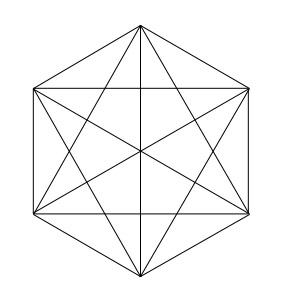The Fano Plane (of order 2) was invented as a sort of a game for mathematicians, by mathematician Gino Fano. The game was to try to make a projective plane with the smallest possible number of points and lines, 7 each, with 3 points on every line and 3 lines through every point. This problem remained a difficult one, until someone remembered that not all lines need be straight. A circle was then added to the projective plane to create what we know as the Fano Plane today. (Note; I am sort of paraphrasing history here).
The Fano Plane is isomorphic with PSL(2,7), which has symmetry with the Klein Quadratic. John Baez linked the Klein Quadratic to the structure of cubes and anti-cubes. I thought that this was interesting and have decided to share some of my observations concerning the Fano Plane, as a result.
When I first saw the Fano Plane it struct me that it was a 2d projection of 3 intersecting lines (or six interconnecting ones) in 3-dimensional space (see above pic). This means that it is, first and foremost, a description of the 3 axis of dimensional space, or the 7 sacred directions; up, down, left, right, forwards, backwards, and the centre. The seven directions are incorporated into the 7 lines and points of the Fano Plane.
The Steiner Roma Projective, based on the Fano Plane.
We can also imagine that the six intersecting lines are the boundary of 8 cubes stacked to form one larger cube. From this we can create a 3D analogue of the Roman projective plane by taking an spheroid made of some kind of elastic substance (like blue-tack) and squashing it between four opposing cubes arranged like so;
The Roman plane has much in common with the stereo view of the Fano Plane, which reminds me of a 3-dimensional waveform. This is interesting because what the stereogram is revealing here is an octahedral structure. The octohedron is, of course, one of the Platonic Solids that turn up in all kinds of interesting places like in the waveforms of vibrating water droplets and the intersecting lines of the Flower of Life.
The octahedron is the dual of the cube, and under certain rotations has a projective plane of the Star of David.
From here it is a simple step to move to the Fano Plane of order 3; or the second smallest projective plane of 9 points. So, we see that the Fano Plane of order 3 is contained and can be derived from the order 2 plane. We can also create a similar 3-d representation of the order 3 Fano Plane via orientations of partially shaded areas of only two cubes, arranged in opposition like so;
(See if you can figure out which areas of the cube need to be shaded).
Interestingly, the order 3 Fano Plane also makes a ghost appearance in this graph, which shows the symmetry between the points and the lines.
For a full depiction of this thought process, see this recreation of my notes;
As far as symmetries are concerned, Wikipedia has this to say;
The full collineation group (or automorphism group, or symmetry group) is the projective linear group PGL(3,2)[1] which in this case is isomorphic to the projective special linear group PSL(2,7) = PSL(3,2), and the general linear group GL(3,2) (which is equal to PGL(3,2) because the field has only one nonzero element). It consists of 168 different permutations.
There are 7 points, and 24 symmetries fixing any point.
There are 7 lines, and 24 symmetries fixing any line.
7 multiplied by 24 gives us 168. This links the Fano Plane with the Klein Quadratic which can be constructed out of 24 heptagons equalling 168. The number 168 has been discussed before on this blog in relation to the speed of light and atomic structure. The speed of light is obviously the basis for time, and atomic structure the basis of matter (i.e. space). As we know, the Fano Plane is in one sense a description of 3-dimensional space, as well as how matter distorts spacetime (See here). It is interesting therefore that its construction and symmetries should be so in line with our terrestrial perception of time (i.e. 24 hours, 7 days a week). It is as if the fundamentals of mathematical structure of space, as exemplified by the Fano Plane, leads us inexorably to this perception, and no other.
In other words, our Earthly division of time – whilst seemingly arbitrary – must be intrinsic to the nature all of reality on a fundamental spatial level. Why this may be so is another question entirely.










Deeply as I layed dreaming
ReplyDeletefrom a Xmas tree came streaming
A troop of cockroaches from the top
after soom time their movement stopped
The number always pleases
But often time teases
was it 88 or 81 negative things
prehaps its as you say 168 beings